Have you been considering chinchillas as pets? Chinchillas are super soft, cute animals that are gentle and family-friendly. If you have a family member with allergies, you will love that chinchillas don’t have dander! Chinchillas are pretty easy to care for as pets but they do need a comfortable habitat and lots of attention to thrive. We adopted our pet chinchilla seven years ago and we will share our tips for how to take care of chinchillas along with some cute chinchilla pictures!
Some pet stores sell chinchillas in their small pet section. Chinchilla care is much like guinea pig care with the later being a much more common rodent. Chinchillas are native to the Andes mountains in South America. Wild chinchillas have seen a population decrease and can now only be found in Chile. While they are fairly uncommon, they do make wonderful pets. My local pet store does not sell them but they do sell food and equipment for proper care of your chinchilla.
Are chinchillas easy to take care of?
Are chinchillas good pets? I believe they are great pets for older children who will spend time interacting and caring for them. Are chinchillas hard to take care of?No, but they do have special needs and require time and attention like all pets. Chinchillas are low-maintenance in some ways (like smell and grooming), but high-maintenance in others (like environment and handling). They’re best for calm, patient, and informed owners who can commit to their unique care needs for many years (long life span). Read on to learn everything you need to know about chinchillas.
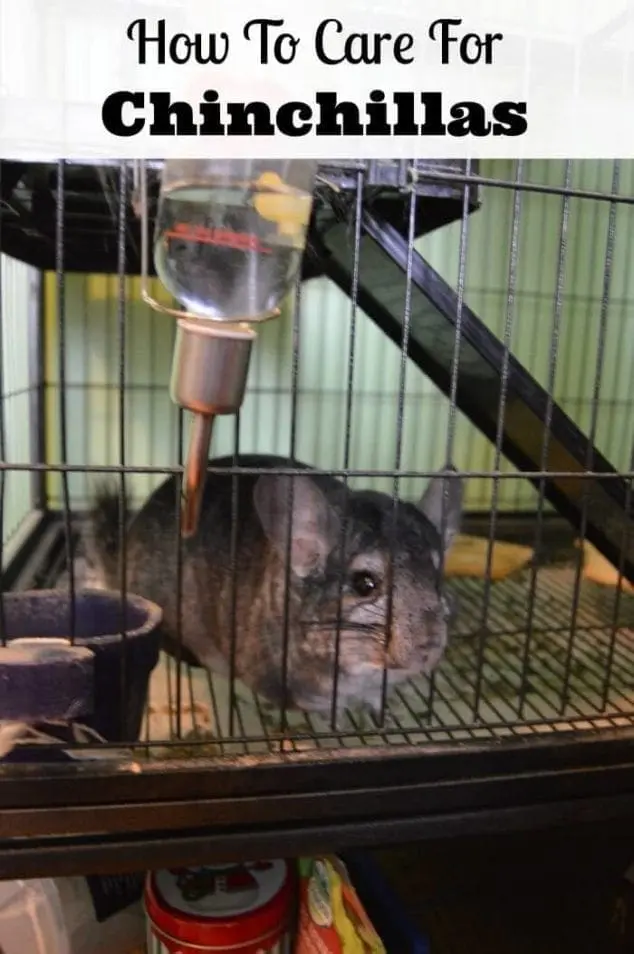
How to Take Care of a Chinchilla
As with any pet, they’ll need fresh water, proper food, a well-maintained habitat, and some human contact. If you’ve recently adopted a chinchilla or you’re thinking about bringing one into your home, here’s what you need to know to take care of chinchillas. First, I want to point out that the lifespan of a pet chinchilla is around 15 years. This is a pretty long time and important to be aware of before you buy or adopt a chinchilla. We adopted our chinchilla, Mickey, from a girl at my daughter’s school who had Mickey for several years before they needed to find him a new home. (She named him Mickey because of his large ears.) That was seven years ago and he has been an excellent pet.
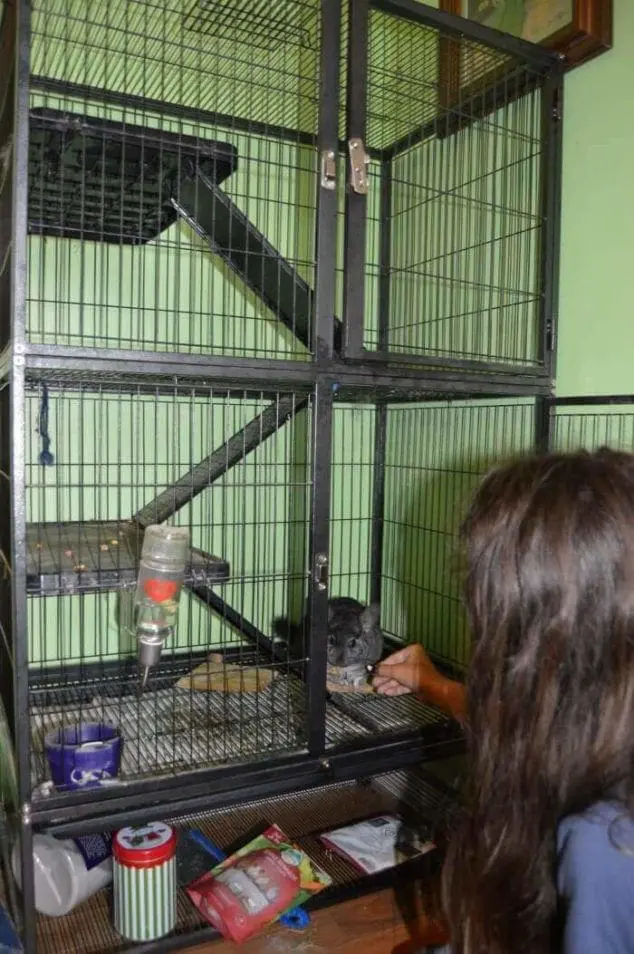
The Best Habitat For Chinchillas
Best Cage For Chinchillas
Care of chinchillas requires a metal cage. They can be very active so it’s important for them to have room to move around. The cage bars need to be close enough that the chinchilla can’t get its head through. If it can get its head out, it can get its whole body out and escape.
When we adopted Mickey, he came with a small cage that looked like a bunny cage they may have gotten at the pet store. My daughter used her birthday money to buy him a Mickey Mansion (large multi-level cage)! We selected our new chinchilla cage on Amazon (affiliate link here) and the great thing is that it doesn’t need to set on anything and it goes up vertically so it doesn’t take up too much room while still providing him with lots of space and levels to climb. Most cages come with solid plastic levels but you can make your own wood levels for the cage as well. Chinchillas love to jump and climb so multiple levels are great.
We like the wire floors because his poop and pee can fall through to the tray below. The wire bottom is the best way for easy clean up. The levels in his cage are flat plastic so that his feet can get a break from the wire. We also put in fresh pieces of cardboard each week. These provide him with another solid floor option for him to sit on and chew at his leisure.
The chinchilla cage should be kept high, on a table or counter, as they don’t like being looked down on. This is a scary situation for them. That is part of why I love the tall cage my daughter selected for our chinchilla.
Chinchillas overheat easily so it is best to keep them in an area that stays between 60 and 70 degrees. Direct sunlight can cause them to get overheated and suffer from heatstroke. For this reason it is a good idea to keep their cage out of direct exposure to the sun.
Access To Chew Toys
Another element to a natural environment for chinchillas to access to plenty of chew toys. While the word toys makes it sound like they are a fun activity, they are more than that. They are actually important to preventing dental problems. A chinchilla’s teeth never stop growing and they need to chew to keep them from growing too long and becoming uncomfortable. Wooden blocks are usually a standard chew toy but they make them in all different ways. Sometimes they bundle sticks and hang from ropes. My pet store seems to have an endless variety of chew toys so Mickey always has something new to check out and munch on.
Nesting Box
A nesting box in the cage will give Chinchillas somewhere to go when they’re scared or tired. They’re den dwelling prey animals so they like small tight spaces to hide. It should be made of chew-proof material and big enough that your chinchilla can get in and move around. It should be placed on the floor, not on one of the levels, because it can get knocked down. These little creatures also love hanging tents and/or hammocks to cozy up in. These make great hiding places for them to feel safe.

Small Pet Playpen
Our chinchilla, Mickey, loved to run around my daughter’s room but she had to prepare her room before letting him out. Most small pets will chew on wires if they are not unplugged and placed out of reach. This is dangerous to the animal and a real bummer for you. She had to take time to block the electrical cords and stop up entrance to any small holes under furniture that would make retrieving him hard. We found a great solution- the SONGMICS Small Pet Playpen.
This super cool pet playpen is made of flat plastic panels which you can configure in several different formations to suit the needs of your room shape and size. There 8 floor panels that are almost 12″ by 12″ so the SONGMICS pet enclosure offers about 8 square feet of floor space. This provides a roomy area for your chinchilla (or guinea pigs, hamsters, hedgehogs, or bunnies) to run, explore, and have fun. I usually put a cardboard box in there for him to play in and chew on as well as a few treats for him to find and a few toys to manipulate.
The side panels are transparent so you can sit down and watch your adorable creatures run around and check things out. This pet fence is so convenient for letting him out to play without having to watch him closely the entire time. The flat plastic is also easy to simply wipe clean surface. The modular, lightweight structure is also easy to disassemble or reconfigure. The SONGMICS playpen really makes interacting with him so much easier. Also, my daughter can let him play while she does her homework without having to worry about him getting into mischief or pooping little pellets all around her room.
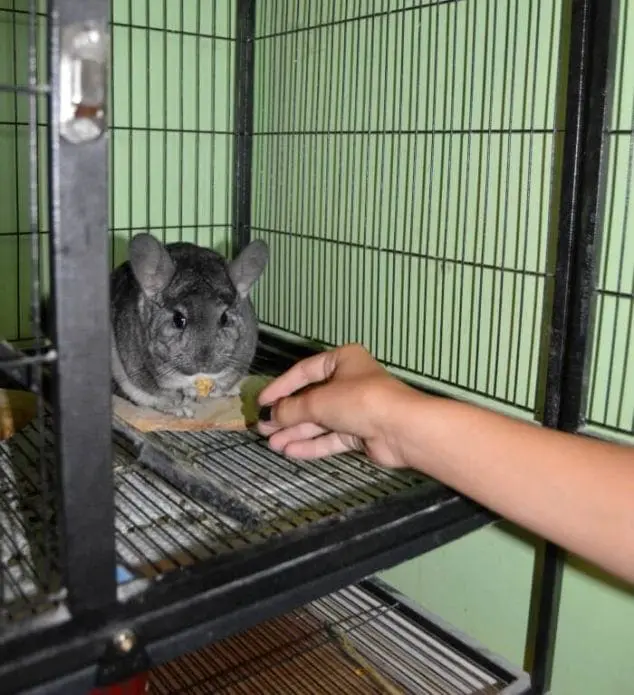
Pet Chinchilla Diet
What does a chinchilla eat anyway? A well-balanced diet includes high-quality chinchilla food pellets with limited amounts of fruits and vegetables. They also need access to Timothy hay at all times. Clean, filtered, chlorine-free water should be provided in a rodent glass water bottle and changed daily.
To properly care for chinchillas, pellets, hay, and water should be available at all times. You can give them fresh fruits and vegetables too, but in very small quantities. No more than 10% of their total diet should be fresh leafy greens and less than 1 tsp/day should be fruits. Any produce not consumed within 24 hours needs to be thrown out. You can get more details on types of greens that are good for your chinchilla here.
Our chinchilla does not like fresh fruit or veggies (maybe because he never had them at a young age) but he does like dried fruit and veggie chinchilla treats from the pet store. We give him a total of 1 or 2 fruit and/or veggie treats a day. A proper diet is important the health small animals. This seems obvious but avoid chocolate, caffeine, sugar, and high-fat treats as these can lead to serious medical problems.
Chinchillas Are Self Grooming
Chinchillas do a fantastic job grooming themselves but they do need access to a dust bath at least twice a week. We have a chinchilla dust bath house which we place in the cage for about 15 minutes twice a week. He goes in and rolls around which makes his coat all soft and fluffy. We remove the dust bath house after he is done so he doesn’t make a mess all the time. Chinchillas do not need a water bath- avoid getting chinchillas wet as this can be dangerous for their sensitive body temperature.
While chinchillas do an excellent job keeping their thick fur clean, they need your help with the habitat. The cage we have has a pull out drawer for catching his pee and poo so that makes that part much easier. The chinchilla cage should be cleaned and disinfected weekly. Rinse and allow the cage to completely dry before placing your chinchilla back inside.
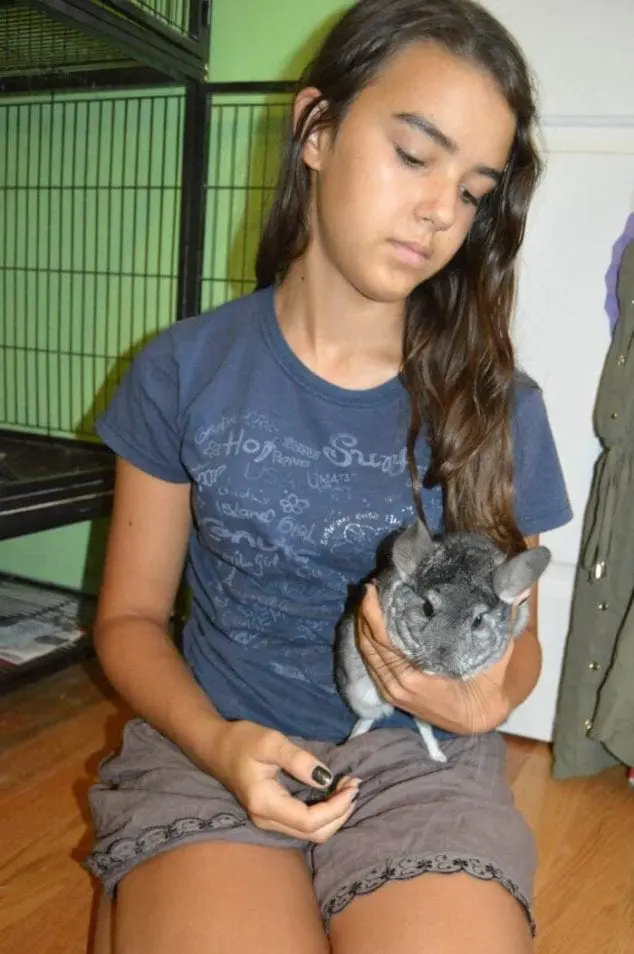
Holding Chinchillas
Be gentle when handling chinchillas, they have a very fragile rib cage. Most chinchillas are very social animals and they really like company of another chinchilla or interaction with a person. However, go slow and respect the signs that show they are comfortable or not happy. When we first adopted Mickey, our pet chinchilla, he was not very social. He was naturally a little frightened of the change of location and people. He would make a “nack”ing noise if we came too close to the cage. Eventually he got more comfortable and only made the noise if we came too close to him. Finally, he got used to us and he would come over to the cage bars to get his pets and get his treats. Now, he even runs into my daughter’s hands and sometimes he sits on her shoulder.
Note: You can have bonded chinchilla pairs but you always need a second separate cage (or you could split a tall cage like ours into two cages by adding a barrier) because they can change their mind and could harm or even kill the other. They can live completely happy alone as Mickey does with attention from us.
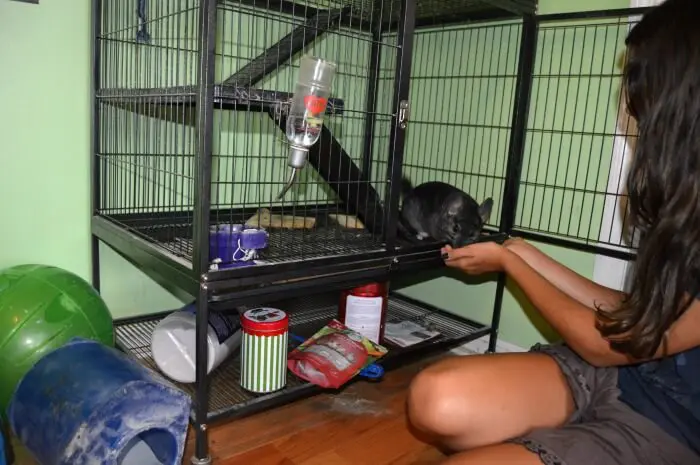
Mickey prefers my daughter but he likes me pretty well too!
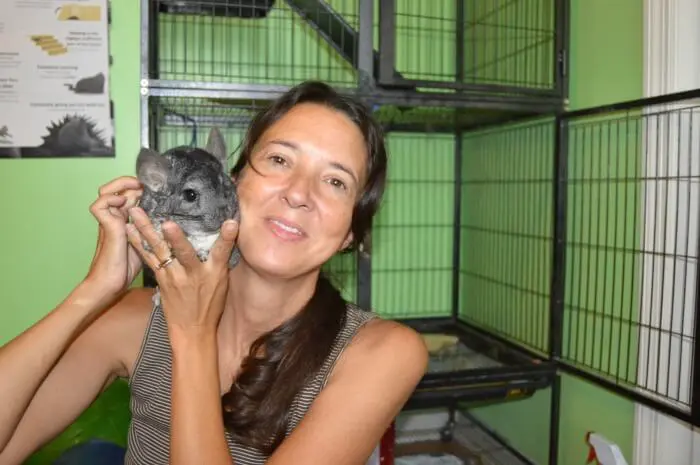
Chinchilla Pet Care Conclusion
Are chinchillas easy to take care of? Yes, I’d say so. Caring for a chinchilla requires time and special equipment, but they are adorable pets that are sweet and loving. They need to be fed and watered every day. Chinchillas also need a dust bath twice a week and their cage to be cleaned at least once a week. That is how to care for a chinchilla and it is all very easy to do! They also love to be scrubbed on their soft fur under the chin and given a treat every day. But what could be more fun?
I hope you find my chinchilla care tips helpful. Giving your chinchilla a quality home will guarantee them a long and happy life. If you get chinchilla as pets, please let me know how it goes and send me your chinchilla pictures @familyfocusblog!
Related Posts:
4 Unique Ways To Teach Kids Responsibility

Carolyn says
Chinchillas are great pets. We love ours. They live a pretty long time for a small pet too.
Mirza says
I never saw a pet chinchilla before! How interesting. It is so nice that you were able to adopt a chinchilla and give him a good home. He is super cute and it is cool that he seems to enjoy human interaction. Thanks for this chinchilla everything you need to know article.
Mohammed Rizwan says
First and foremost, thank you for sharing such a comprehensive article about caring for a chinchilla. These little creatures are absolutely adorable, but I had no idea how specific their needs are. It’s great to know that they’re clean and have minimal odor, but I was surprised to learn how sensitive they are to heat and how important dust baths are for their fur. Your tips really highlight that chinchillas aren’t low-maintenance pets, but with the right setup and attention, they can thrive. This post is a great reminder to research thoroughly before bringing any pet home. Thanks for this helpful post on chinchilla care.
Alene says
This is a good overview of chinchilla care, covering the basics of food, habitat, and enrichment. It is well-written and informative, with helpful tips for those who are considering getting a chinchilla as a pet. I especially appreciate the emphasis on the importance of interaction and attention for chinchillas. Overall, this is a valuable resource for anyone who wants to learn more about how to care for a chinchilla.
Marjorie Will says
Chinchilla pets are not great for small children because of rough handling or being held a lot. They can be stressed easily.
Wade says
This chinchilla care guide from Family Focus Blog is like the cozy fleece hammock every chinchilla deserves—thoughtful, supportive, and impressively thorough. Scarlet does a great job of balancing practical care info with personal anecdotes, like Mickey’s evolution from “nack-ing” stranger danger to shoulder-hopping bestie. There’s real warmth in the writing, especially the way she frames care tasks—like the weekly dust bath—not as chores, but part of a happy chinchilla-human relationship.
Duwayne says
This chinchilla care guide is chef’s kiss for anyone even thinking about adopting one of these fluffballs. It’s thorough without being overwhelming—like chatting with a friend who just happens to know everything about exotic rodents. From Mickey’s multi-level “Mansion” to that genius pet playpen hack, the personal touches made the advice so relatable.
Dr. Noman's Dental Corner says
Wow, who knew chinchillas were such divas with their dust baths and climate control demands? I always thought pets were low-maintenance until I met these fluffy little furballs—apparently, they’re more “spa day” than “walk in the park.” Also, the whole “no head escapes allowed” cage rule cracked me up. Definitely giving me serious Houdini vibes!
Bucktown Grading and Construction says
Wow, Mickey sounds like he’s living in the chinchilla equivalent of a Beverly Hills condo—with dust baths instead of infinity pools. I always thought chinchillas were kind of like introverted bunnies, but this guide really opened my eyes (and now possibly my Amazon cart). Curious though—has Mickey ever Houdini’d his way out of the cage? Mine would probably form a tiny rebellion with the cat.
Scarlet says
Nope, Mickey has never escaped his cage. He did jump out of his play pen a few times though. Mickey does not like our cat and he rushes the cage bars if the cat gets in the room! The cat ignores him completely but I suspect the cat is just trying lull us into complacency and I am not falling for it.